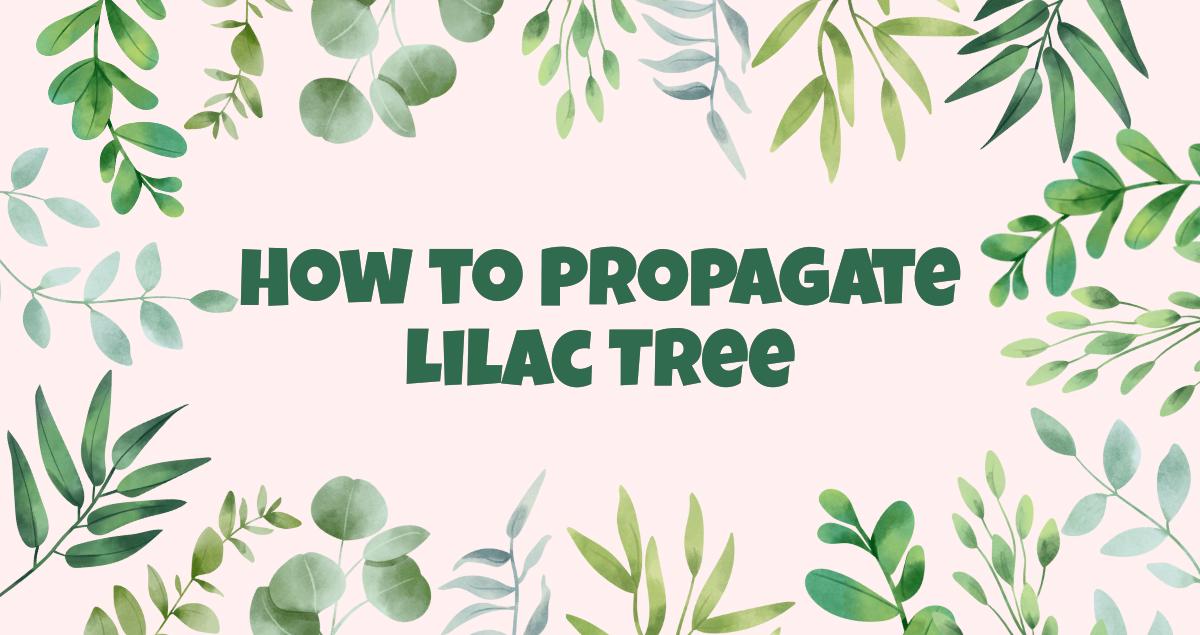Introduction to lilac trees and their characteristics
Table of Content
How to Propagate Lilac Tree
To propagate a lilac tree, start by taking softwood cuttings in early summer. Remove the lower leaves and dip the cut end in rooting hormone. Plant the cuttings in a well-draining soil mix, keep them moist, and provide indirect light. After a few weeks, the cuttings should develop roots. Transplant them into larger pots and gradually acclimate them to outdoor conditions before planting them in the ground.
Understanding Lilac Trees
Lilac trees are known for their beautiful and fragrant flowers, making them a popular choice for gardens and landscapes. These deciduous trees belong to the genus Syringa and are native to Europe and Asia. They are known for their vibrant blooms in shades of purple, pink, white, and even yellow. Lilac trees can grow up to 15 feet tall and have a spread of about 10 feet, making them an excellent choice for adding height and color to any garden.
Propagation is the process of creating new plants from existing ones, and it plays a crucial role in gardening. It allows gardeners to expand their plant collection, preserve rare or unique varieties, and share plants with others. Propagation can be done through various methods, including seeds, cuttings, and layering. In this article, we will explore different methods of propagating lilac trees and provide step-by-step instructions for each.
Methods of Propagating Lilac Trees
There are several methods you can use to propagate lilac trees, depending on your preferences and available resources. Let's take a closer look at each method:
1. Propagation by Seeds
Propagating lilac trees from seeds is a straightforward process that requires some patience. To start, collect ripe lilac seeds from the tree in late summer or early fall. Remove the seeds from the seed pods and soak them in water for 24 hours. After soaking, plant the seeds in a well-draining potting mix and keep them in a warm and sunny location. Water the seeds regularly and be patient, as it may take several weeks or even months for them to germinate. Once the seedlings have grown a few inches tall, you can transplant them into individual pots or directly into the garden.
2. Propagation by Cuttings
Propagating lilac trees through cuttings is a popular method because it allows you to create new plants that are genetically identical to the parent plant. To propagate through cuttings, select a healthy branch from the lilac tree in early summer. Make a clean cut just below a leaf node, and remove any flowers or buds. Dip the cut end of the cutting in rooting hormone to encourage root development, and then plant it in a pot filled with a well-draining potting mix. Place the pot in a warm and bright location, and keep the soil consistently moist. After a few weeks, the cutting should develop roots, and you can transplant it into a larger pot or directly into the garden.
3. Propagation by Layering
Layering is another method of propagating lilac trees that involves bending a low-growing branch to the ground and encouraging it to root while still attached to the parent plant. To propagate through layering, select a healthy branch that is flexible and close to the ground. Remove any leaves or flowers from the section of the branch that will be buried. Dig a small trench in the soil next to the branch and gently bend the branch into the trench. Cover the buried portion of the branch with soil and secure it in place with a stake or rock. Keep the soil moist, and after a few months, the buried section of the branch should develop roots. At this point, you can cut the rooted branch from the parent plant and transplant it into a new location.
Preparing Lilac Tree Cuttings
When propagating lilac trees through cuttings, it is essential to prepare the cuttings properly to increase their chances of success. Here are some important considerations and steps to follow:
1. Choosing the Right Time
The best time to take lilac tree cuttings is in early summer when the branches are actively growing. Avoid taking cuttings during periods of extreme heat or cold, as this can stress the plant and reduce the chances of successful rooting.
2. Selecting Healthy Branches
Choose branches that are healthy, disease-free, and free from any signs of damage or stress. Look for branches that are young and flexible, as these are more likely to root successfully.
3. Preparing the Cuttings
Make clean cuts just below a leaf node using sharp and clean pruning shears. Remove any flowers or buds from the cutting, as these can divert energy away from root development. Dip the cut end of the cutting in rooting hormone to stimulate root growth, and then plant it in a pot filled with a well-draining potting mix. Keep the soil consistently moist and provide the cutting with bright, indirect light to encourage root development.
Propagating Lilac Trees in Containers
If you prefer to propagate lilac trees in containers, here are some guidelines to follow:
1. Choosing the Right Container
Select a container that is large enough to accommodate the lilac tree cutting and has drainage holes at the bottom. The container should be made of a durable material, such as plastic or terracotta, and should be clean and free from any contaminants.
2. Potting Mix and Planting
Prepare a well-draining potting mix by combining equal parts of peat moss, perlite, and vermiculite. Fill the container with the potting mix, leaving enough space for the lilac tree cutting. Plant the cutting in the container, making sure that the soil is in contact with the base of the cutting. Gently firm the soil around the cutting to provide support.
3. Care and Maintenance
Place the container in a warm and bright location, but avoid direct sunlight, as this can scorch the cutting. Water the cutting regularly, keeping the soil consistently moist but not waterlogged. Monitor the container for any signs of pests or diseases, and take appropriate action if necessary. As the cutting develops roots and grows, you may need to transplant it into a larger container or directly into the garden.
Conclusion
Propagating lilac trees is a rewarding experience that allows you to create new plants and expand your garden. Whether you choose to propagate through seeds, cuttings, or layering, each method has its own advantages and considerations. By following the proper techniques and providing the necessary care, you can successfully propagate lilac trees and enjoy their beautiful blooms for years to come.
Frequently Asked Questions
Can you start a lilac tree from a cutting?
Yes, you can start a lilac tree from a cutting. Take a 6-8 inch cutting from a healthy lilac branch in early summer. Remove the lower leaves and dip the cut end in rooting hormone. Plant the cutting in a pot filled with well-draining soil and keep it in a warm, bright location. Water regularly and provide misting to maintain humidity. After a few weeks, roots will develop, and you can transplant the cutting into a larger container or directly into the ground.
Will lilac cuttings root in water?
Yes, lilac cuttings can root in water. Take a 6-8 inch cutting from a healthy lilac branch in early summer. Remove the lower leaves and place the cut end in a container filled with water. Keep the cutting in a warm, bright location and change the water every few days to prevent stagnation. After a few weeks, roots will start to grow, and you can transfer the cutting to a pot with well-draining soil or directly into the ground.
How do you start a lilac tree?
To start a lilac tree, you have a few options. One method is to take a cutting from a healthy lilac branch in early summer, remove the lower leaves, dip the cut end in rooting hormone, and plant it in a pot or directly in the ground. Another way is to propagate through layering, where you bend a low-growing branch to the ground, wound it, and cover it with soil until roots develop. You can also grow lilac trees from seeds, but it takes longer for them to mature and bloom.
How fast do lilac cuttings grow?
Lilac cuttings usually take a few weeks to a couple of months to grow roots and establish themselves. The exact speed of growth can vary depending on factors such as the health of the cutting, environmental conditions, and the propagation method used. It's important to provide proper care and attention to the cuttings during this period, ensuring they receive adequate sunlight, moisture, and nutrients to support their growth.
When is the best time to take lilac cuttings?
The best time to take lilac cuttings is in early summer when the plant is actively growing. Look for healthy, non-flowering shoots and take 6-8 inch cuttings from them. Avoid taking cuttings from weak or diseased branches. By taking cuttings during this period, you increase the chances of successful root development and overall propagation success.
Can I propagate lilac tree from suckers?
Yes, you can propagate a lilac tree from suckers. Suckers are new shoots that emerge from the base of the lilac tree. To propagate using suckers, carefully dig around the sucker to expose its roots, ensuring you don't damage them. Once the roots are visible, sever the sucker from the parent plant using a sharp, clean cut. Transplant the sucker into a prepared hole in well-draining soil, water it thoroughly, and provide regular care to help it establish as a new lilac tree.
What is the best soil for propagating lilac tree?
The best soil for propagating lilac tree is well-draining soil that is rich in organic matter. Lilacs prefer slightly alkaline soil with a pH level between 6.5 and 7.5. Ensure the soil is loose and friable, allowing for good root development and water drainage. If the soil in your area is heavy or clay-like, you can amend it with compost or well-rotted manure to improve its texture and fertility, creating an ideal environment for successful lilac propagation.

